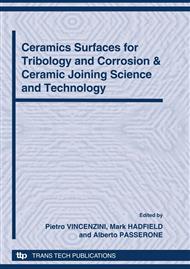p.43
p.49
p.59
p.65
p.71
p.76
p.83
p.88
p.98
Mechanical Properties of Silicon Nitride Using RUS & C-Sphere Methodology
Abstract:
Silicon nitride is a type of engineering ceramic which has been used in ball bearing and other rolling contact applications owing to its good fatigue life, high temperature strength and tribological performance. In this paper, the mechanical properties of Hot Isostatically Pressed (HIPed) and Sintered and Reaction Bonded Silion Nitride (SRBSN) have been studied. The elastic modulus and poisson’s ratio of three types of commerical grade HIPed silicon nitride, and ground SRBSN with three surface condidtions were measured using a Resonance Ultrasound Spectroscopy (RUS). The RUS measurement reveals the variation of elastic properties across different types of HIPed silicon nitride specimens. The surface strength of silicon nitride are studied using a C-sphere specimen, and the results show that SRBSN with three different surface finishing conditions show varied surface strength. The RUS and C-sphere techniques can potentially be used to sample the quality and consistency of ball bearing elements.
Info:
Periodical:
Pages:
71-75
Citation:
Online since:
October 2010
Authors:
Keywords:
Price:
Сopyright:
© 2010 Trans Tech Publications Ltd. All Rights Reserved
Share:
Citation:


